
The Agaricales are an order of fungi in the division Basidiomycota. As originally conceived, the order contained all the agarics, but subsequent research has shown that not all agarics are closely related and some belong in other orders, such as the Russulales and Boletales. Conversely, DNA research has also shown that many non-agarics, including some of the clavarioid fungi and gasteroid fungi belong within the Agaricales. The order has 46 extant families, more than 400 genera, and over 25,000 described species, along with six extinct genera known only from the fossil record. Species in the Agaricales range from the familiar Agaricus bisporus and the deadly Amanita virosa to the coral-like Clavaria zollingeri and bracket-like Fistulina hepatica.

The Strophariaceae are a family of fungi in the order Agaricales. Under an older classification, the family covered 18 genera and 1316 species. The species of Strophariaceae have red-brown to dark brown spore prints, while the spores themselves are smooth and have an apical germ pore. These agarics are also characterized by having a cutis-type pileipellis. Ecologically, all species in this group are saprotrophs, growing on various kinds of decaying organic matter. The family was circumscribed in 1946 by mycologists Rolf Singer and Alexander H. Smith.

The Marasmiaceae are a family of fungi in the order Agaricales. Basidiocarps are most frequently agarics, but occasionally cyphelloid. According to a 2008 estimate, the family contained 54 genera and 1590 species, but molecular research, based on cladistic analysis of DNA sequences, has led to a more restricted family concept, so that the Marasmiaceae included just 13 genera, and some 1205 species. It was reduced further down in 2020, to 10 genera and about 700 species.

Tylopilus is a genus of over 100 species of mycorrhizal bolete fungi separated from Boletus. Its best known member is the bitter bolete, the only species found in Europe. More species are found in North America, such as the edible species T. alboater. Australia is another continent where many species are found. All members of the genus form mycorrhizal relationships with trees. Members of the genus are distinguished by their pinkish pore surfaces.

The Entolomataceae are a family of fungi in the order Agaricales. The family contains eight genera and 2250 species, the majority of which are in Entoloma. Basidiocarps are typically agaricoid, but a minority are cyphelloid. secotioid, or gasteroid. All produce pink basidiospores that are variously angular (polyhedral), ridged, or nodulose. Species are mostly saprotrophic, though a few are parasitic on other fungi. The family occurs worldwide.

Xerocomus is a genus of poroid fungi related to Boletus. Many mycologists did not originally recognize the distinction between the two genera and placed Xerocomus taxa in genus Boletus. However, several molecular phylogenetic studies have demonstrated that Xerocomus is a heterogeneous genus of polyphyletic origin, which has resulted in further division of Xerocomus into Xerocomellus and Hemileccinum. The members of the genus Xerocomellus are more closely related to Boletus than true Xerocomus is, which is relatively distantly related to Boletus and more closely related to Phylloporus. Other former Xerocomus species have since been moved to Aureoboletus, Imleria, Hortiboletus and Rheubarbariboletus.
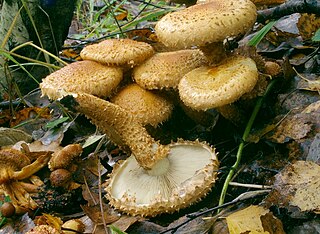
Pholiota is a genus of small to medium-sized, fleshy mushrooms in the family Strophariaceae. They are saprobes that typically live on wood. The genus has a widespread distribution, especially in temperate regions, and contains about 150 species.

The Inocybaceae are a family of fungi in the order Agaricales, the largest order of mushroom-forming fungi. It is one of the larger families within Agaricales. This family exhibits an ectomycorrhizal ecology. Members of this family have a widespread distribution in tropical and temperate areas.

Boletellus is a genus of fungi in the family Boletaceae. The genus has a widespread distribution, especially in subtropical regions, and contains about 50 species. The genus was first described by American mycologist William Alphonso Murrill in 1909. The genus name means "small Boletus".
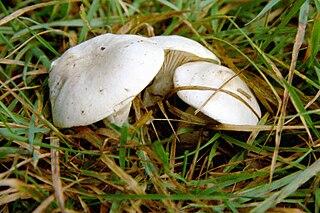
Clitopilus is a genus of fungi in the family Entolomataceae. The genus has a widespread distribution, especially in northern temperate areas. Although a 2008 estimate suggested about 30 species in the genus, a more recent publication (2009) using molecular phylogenetics has redefined the genus to include many former Rhodocybe species.
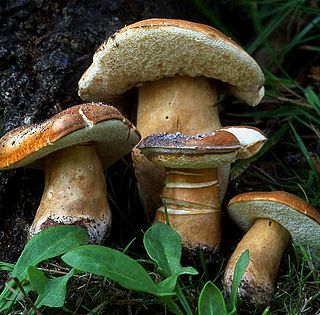
The Gyroporaceae are a family of fungi in the order Boletales. The family is monogeneric, containing the single genus Gyroporus, which, according to a 2008 estimate, contains ten widely distributed species, though a more recent study inferred the species-level diversity to be far higher.
Arthrosporella is a fungal genus in the family Tricholomataceae. It is a monotypic genus, containing the single species Arthrosporella ditopa, found in South America. The genus was described by mycologist Rolf Singer in 1970.

Pseudoomphalina is a genus of fungi in the placed in the family Tricholomataceae for convenience. The genus contains six species that are widespread in northern temperate areas. Pseudoomphalina was circumscribed by Rolf Singer in 1956. Pseudoomphalina was found to be paraphyletic to Neohygrophorus in a molecular phylogenetics study and since Pseudoomphalina is an older name, Neohygrophyorus was synonymized with it. The type species of Neohygrophorus was Neohygrophorus angelesianus, now Pseudoomphalina angelesiana. In earlier classifications based on anatomy prior to DNA sequence-based classifications, its unusual combination of features led taxonomists to independently create two subgenera in two genera: Hygrophorus subg. Pseudohygrophorus and Clitocybe subg. Mutabiles; the latter based on Neohygrophorus angelesianus but described under a new species name which is now placed in synonymy, Clitocybe mutabilis. All species of Pseudoomphalina are united by the presence of clamp-connections in their hyphae, an interwoven gill trama and amyloid spores. Pseudoomphalina angelesiana possesses grey-violaceous pigments that turn red in alkali solutions and lacks filiform, hyphal sterile elements in its hymenium and stipitipellis. These were features used to distinguish it from Pseudoomphalina as a genus, but Pseudoomphalina umbrinopurpurascens possesses these same pigments and the filiform elements of Pseudoomphalina. Molecular phylogenetics studies have also found some former species of Pseudoomphalina to belong in other genera. Pseudoomphalina pachyphylla was moved to its own genus, Pseudolaccaria, and Pseudoomphalina clusiliformis was synonymized with it. Pseudoomphalina flavoaurantia and Pseudoomphalina lignicola were found to belong in Clitocybula. Phylogenetically, Pseudoomphalina is in a tricholomatoid clade but not in the Tricholomataceae.
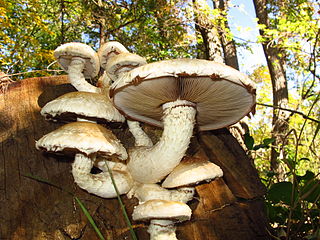
Hemipholiota is a genus of agaric fungi in the order Agaricales. It was originally proposed by Rolf Singer in 1962 as a subgenus of Pholiota to contain species with absent or sparse pleurocystidia and absent chrysocystidia. Henri Romagnesi raised it to generic status in 1980, but this naming was invalid as it did not meet the requirements of the International Code of Nomenclature for algae, fungi, and plants. Marcel Bon published the genus validly in 1986.
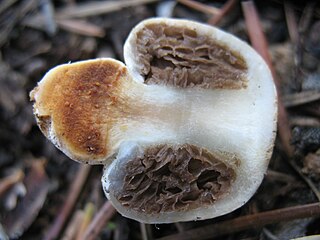
Nivatogastrium is a genus of secotioid fungi in the family Strophariaceae. The genus has contained four species found in North America and New Zealand, but the type species, Nivatogastrium nubigenum, is now considered to be a gasteroid species of Pholiota, and was transferred to that genus in 2014.
Lulesia densifolia is a species of fungus that was first described by Rolf Singer in 1970. It is the type species of the genus Lulesia. As with the other two species in this genus, L. densifolia is found in the tropics.
David Norman Pegler is a British mycologist. Until his retirement in 1998, he served as the Head of Mycology and assistant keeper of the herbarium at the Royal Botanic Gardens in Kew. Pegler received his BSc from London University in 1960, thereafter studying tropical Agaricales with R.W.G. Dennis as his graduate supervisor. He earned a master's degree in 1966, and a PhD in 1974. His graduate thesis was on agarics of east Africa, later published as A preliminary agaric flora of East Africa in 1977. In 1989, London University awarded him a DSc for his research into the Agaricales.
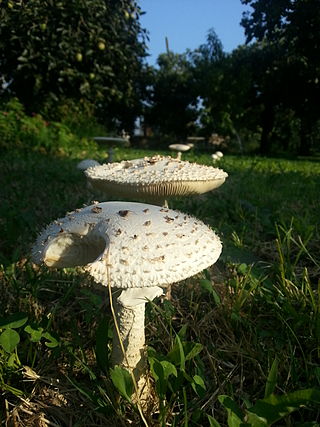
The genus Saproamanita contains about 24 species of agarics and is one of six genera in the family Amanitaceae, of which the similar Amanita is also a member. Saproamanita differs from Amanita in that its species are saprophytic, and not ectomycorrhizal.
Aurantiopileus is a genus of three species of poroid fungi in the family Meruliaceae.















